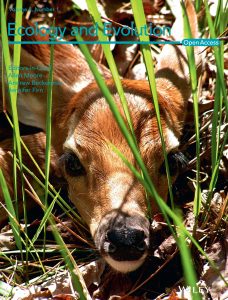Peer-reviewed
(**- Undergraduate Author, *-Graduate Author)
Undergraduate Author, *-Graduate Author)
2022-present
Brown, TA*, Nawaz S**, Ramirez Cuenca M**, Burns M. 2025. No evidence for a female mating status effect on reproductive behavior in the polygamous arachnid Leiobunum vittatum. Ecology & Evolution: Submitted.
Brown, TA*, Marinko E**, Burns M. 2025. The reduction of nuptial gifts in sclerosomatid Opiliones coincides with an increase in sexual-conflict like behavior. Animal Behavior 223.
Bacon R*, Washington D**, Johnson MK**, Burns M. 2022. The geography of sexual conflict: a synthetic review. American Naturalist 201(3). https://doi.org/10.1086/722797.
Machado G, Burns M. 2022. Reproductive biology of harvestmen (Arachnida: Opiliones): A review of a rapidly evolving research field. Current Zoology, zoac102. doi.org/10.1093/cz/zoac102.
2018-2021
Stellwagen SD, Burns M. 2021. Repeat variation resolves a complete aggregate silk sequence of bolas spider Mastophora phrynosoma. Integrative and Comparative Biology 61(4): 1450-1458.
Brown T*, Tsurusaki N, Burns M. 2021. Genomic determination of reproductive mode in facultatively parthenogenetic Opiliones. Journal of Heredity 112(1): 34-44. doi: 10.1093/jhered/esaa045
Karachiwalla Z**, deCarvalho T, Burns M. 2020. Spermathecal variation in temperate Opiliones. Integrative and Comparative Biology: icaa120. doi: 10.1093/icb/icaa120
Orr T, Burns M, Hawkes K, Holekamp KE … Hayssen V. 2020. It takes two to tango: including a female perspective in reproductive biology. Integrative and Comparative Biology 60(3): 796-813. doi: 10.1093/icb/icaa084
Kahn P**, Cao D, Burns M, Boyer S. 2018. Comparison of nuptial gift chemistry reveals convergent evolution correlated with antagonism in mating system. Ecology and Evolution 8(14): 7103-7110. doi: 10.1002/ece3.4232.
2012-2017
Burns M, Hedin M, Tsurusaki N. 2017. Population genomics and geographical parthenogenesis in Japanese harvestmen (Opiliones, Sclerosomatidae). Ecology and Evolution 8(1): 36-52. doi: 10.1002/ece3.3605.
Shoemaker AK**, Burns M, Boyer S. 2017. New records of harvestmen (Arachnida, Opiliones) from Minnesota, USA. Zootaxa 4273(2): 279-286.
Burns M, Starrett J, Derkarabetian S, Richart CH, Cabrero A, Hedin MC. 2016. Comparative performance of double-digest RAD sequencing across divergent arachnid lineages. Molecular Ecology Resources 17(3): 418-430. doi: 10.1111/1755-0998.12575.
Derkarabetian S, Burns M, Starrett J, Hedin M. 2016. Population genomic evidence for multiple refugia in a montane-restricted harvestmen (Arachnida, Opiliones, Sclerobunus robustus) from the southwestern United States. Molecular Ecology 25(18): 4611-4631. doi: 10.1111/mec.13789.
Burns M, Tsurusaki N. 2016. Male reproductive morphology across latitudinal clines and under long-term female sex ratio bias. Integrative and Comparative Biology 56(1): 715-727. doi:10.1093/icb/icw017.
Burns M, Shultz JW. 2016. Mechanical properties of male genitalia in Leiobunum harvestmen (Arachnida, Opiliones, Sclerosomatidae). Journal of Arachnology 44: 199-209.
Burns M, Shultz JW. 2015. Biomechanical diversity of mating structures among harvestmen species is consistent with a spectrum of precopulatory strategies. PLoS ONE 10(9): e0137181. doi:10.1371/journal.pone.0137181.
Burns M, Hedin M, Shultz JW. 2013. Comparative analyses of reproductive structures in harvestmen (Opiliones) reveal multiple transitions from courtship to precopulatory antagonism. PLoS ONE 8(6): e66767. doi:10.1371/journal.pone.0066767.
Burns M, Hedin M, Shultz JW. 2012. Molecular phylogeny of the leiobunine harvestmen of eastern North America (Opiliones: Sclerosomatidae: Leiobuninae). Molecular Phylogenetics and Evolution 63(2): 291-298.
Broad Audience
Burns M, Stellwagen SD. 2021. The Ties that Stick: Challenges and future promise in the field of bioadhesives. Integrative and Comparative Biology 61(4): 1406-1410.
Burns M. Virgin births from parthenogensis: How females from some species can reproduce without males. The Conversation. December 15, 2020.
Burns M, Raupp M. Myths from the Undergrowth: Four urban legends about arthropods and the truths behind them! Groundwork. August 2010: 6-9.